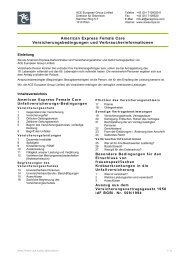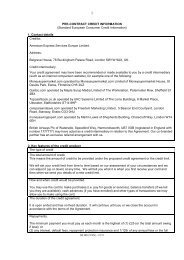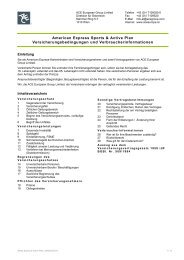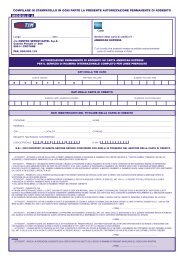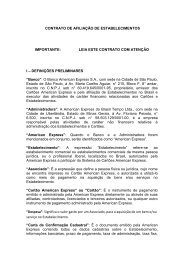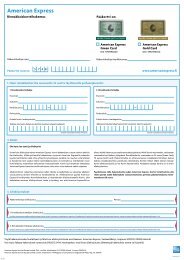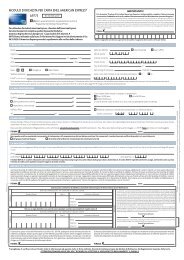American Express
American Express
American Express
Create successful ePaper yourself
Turn your PDF publications into a flip-book with our unique Google optimized e-Paper software.
AMERICAN<br />
EXPRESS<br />
OUR STORY
Becoming <strong>American</strong> <strong>Express</strong>:<br />
150+ Years of Reinvention and Customer Service<br />
INTRODUCTION<br />
The story of <strong>American</strong> <strong>Express</strong> is a fascinating one, filled with interesting and<br />
sometimes quirky characters who -- through a combination of brains,<br />
perseverance and luck -- shaped the company's development during the past<br />
century and a half.<br />
The express company that forwarded freight and valuables evolved into a<br />
company that created and sold financial products like money orders and travelers<br />
cheques. Following an era of international expansion, the company became an<br />
entity perhaps best known for its charge card. Today, <strong>American</strong> <strong>Express</strong> is a<br />
global payments company.<br />
The attributes that today are the hallmarks of the <strong>American</strong> <strong>Express</strong> brand --<br />
trust, integrity, security, quality, customer service -- all have their roots in this<br />
compelling story. In this history, as well, are the genesis and development of the<br />
company's aspiration to become the world's most respected service brand.<br />
Our History
The three principal founders of the <strong>American</strong> <strong>Express</strong> Company:<br />
Henry Wells, William G. Fargo and John Butterfield.<br />
Trust. Security. Vigilance. Service. Long before the creation of the Blue Box logo, <strong>American</strong><br />
<strong>Express</strong> used a watchdog to symbolize these key values when it was founded in 1850. After all, the<br />
success of any express company that delivered valuable goods depended upon the confidence<br />
customers had that the company would safely deliver money and packages.
EXPRESSMEN JOIN FORCES<br />
Established in 1850 in New York, <strong>American</strong> <strong>Express</strong> Company was among the first and most<br />
successful express delivery businesses to arise during the rapid westward expansion of the<br />
United States. The U.S. Postal Service at the time was slow, expensive and nonexistent in many<br />
areas. Nothing larger than a letter-sized envelope could be sent by mail and certainly nothing<br />
valuable, as a fair number of deliveries were lost or stolen enroute.<br />
The express companies served as a lifeline to the growing nation. Intrepid express men, typically<br />
on horseback or driving stagecoaches, traversed from the eastern cities to the western frontier,<br />
transporting correspondence, parcels, freight, gold and currency, among countless other goods.<br />
<strong>American</strong> <strong>Express</strong> quickly earned a reputation as the best in the fledgling industry – the company<br />
that delivered, literally.<br />
Although in its early years <strong>American</strong> <strong>Express</strong> was not itself a financial services company, its<br />
largest and most consistent clients were banks. Delivering the banks’ typically small parcels –<br />
stock certificates, notes, currency and other financial instruments – was considerably more<br />
profitable than transporting larger freight. Soon the company would scale down its parcel and<br />
freight delivery business in favor of creating and selling its own financial products.
INNOVATION AND EXPANSION<br />
In 1882, <strong>American</strong> <strong>Express</strong> launched the money order business, which proved an almost instant<br />
success. The company introduced the world’s first traveler’s cheque in 1891 and within ten years<br />
was selling more than $6 million in cheques annually.<br />
In the course of building the money order and travelers cheque businesses, the company<br />
established correspondent banking relationships with a number of European banks that accepted<br />
and encashed the products. As a result, the <strong>American</strong> <strong>Express</strong> name became increasingly visible<br />
throughout Europe. In 1895, the company established its first European office, in Paris, at 6, rue<br />
Halévy, followed by the 1896 opening of an office at 3 Waterloo Place in London. By 1910,<br />
<strong>American</strong> <strong>Express</strong> had expanded to Southampton, Liverpool, Hamburg, Berlin, Bremen, Antwerp,<br />
Rotterdam, Copenhagen, Naples and Genoa.<br />
Although foreign exchange transactions were conducted as early as 1895 by the Paris office, the<br />
official initiation of the company’s overseas banking operations took place in 1904, when the<br />
Rotterdam office opened in Netherlands and began conducting commercial banking services.<br />
Meanwhile, back in New York, millions of immigrants were entering the United States through<br />
Ellis Island. After uncovering several examples of flagrant swindling among the independent<br />
moneychangers on the premises, the U.S. Immigration Department awarded a contract to<br />
<strong>American</strong> <strong>Express</strong> in 1905 to provide official currency exchange services. Over the years,<br />
countless newcomers completed their first business transactions in the United States at the<br />
<strong>American</strong> <strong>Express</strong> teller’s window on Ellis Island.<br />
A singular historic event – the outbreak of World War I in Europe – brought about the next<br />
dramatic transformation of <strong>American</strong> <strong>Express</strong> and more fully shaped it, willingly or unwillingly, into<br />
a travel services company.
WAR AND THE AGE OF TRAVEL<br />
During the summer of 1914, approximately 150,000 <strong>American</strong> tourists were stranded when war<br />
engulfed Europe, many without access to funds. Banks had ceased to pay against foreign letters<br />
of credit or any other form of foreign paper. Panic-stricken travelers lined up inside and outside<br />
the offices of <strong>American</strong> <strong>Express</strong> in whatever city they happened to be visiting. <strong>American</strong> <strong>Express</strong><br />
was able to cash all travelers’ cheques and money orders in full, enabling quick passage home<br />
for thousands. Many of those remaining were able to book passage home soon after a decision<br />
by <strong>American</strong> <strong>Express</strong> and a consortium of nine U.S. banks to ship $10 million in gold to Europe<br />
so that local banks could once again honor foreign drafts.<br />
Throughout the war, <strong>American</strong> <strong>Express</strong> provided other services as well. The company was<br />
appointed official agent of the British government to deliver relief parcels, letters and money to<br />
British prisoners of war in Germany. Eventually, <strong>American</strong> <strong>Express</strong> was delivering 150 tons of<br />
packages a day to British prisoners in Bulgaria, Germany, Holland, Norway, Switzerland and<br />
Turkey. Employees also went into the prisoner of war camps to cash drafts for British and French<br />
prisoners, and made arrangements whereby they could receive money from home.<br />
<strong>American</strong> <strong>Express</strong> officially entered the travel business in 1915. As one executive wrote to the<br />
company’s president earlier that year, “Already, we supply travelers with the tickets for their<br />
European tours; we receive and forward their mail; we provide reading and writing rooms for their<br />
convenience; we store and forward their baggage and packages; we engage their return<br />
steamship accommodations. In fact, we are doing already for travelers practically everything<br />
except that which is most remunerative to ourselves, namely, furnishing eastbound steamship<br />
tickets to Europe; providing hotel accommodations and conducting small parties desiring such a<br />
service.”<br />
Within the decade, <strong>American</strong> <strong>Express</strong> was undertaking tours to Europe, South America, the Far<br />
East, the West Indies and other destinations around the globe. The company became<br />
synonymous with luxury travel after its successful charter in 1922 of the first around-the-world<br />
cruise, a four-month, 30,000-mile voyage of the Cunard liner, Laconia, with stops in Cuba,<br />
Panama, Honolulu, Japan, China, Java, Singapore, India, Cairo and the Mediterranean. (The<br />
Laconia went on to carry passengers around the world for another 20 years, before being<br />
torpedoed and sunk during World War II.)<br />
<strong>American</strong> <strong>Express</strong>’ focus on travel continued through the next several decades. The sale of<br />
traveler’s cheques and money orders – and, more specifically, the float on them and the prudent<br />
and profitable investment of that float – generated the revenue that supported this phase of the<br />
company’s travel endeavors.
MATTERS OF SURVIVAL<br />
<strong>American</strong> <strong>Express</strong> nearly disappeared as an independent company in 1929. Chase National<br />
Bank had been quietly buying up shares of the company for several years. Not until Chase<br />
completed a tender offer for <strong>American</strong> <strong>Express</strong> did it come to light that its prospective buyer<br />
already owned 97 percent of the company.<br />
Two unforeseen and unrelated events saved <strong>American</strong> <strong>Express</strong> from becoming fully absorbed by<br />
Chase. First, the majority of the owners of the remaining 4,702 shares of <strong>American</strong> <strong>Express</strong><br />
balked at selling them, either refusing outright or demanding exorbitant prices. Second, in 1933,<br />
the U.S. Congress passed the Glass-Steagall Act, which prohibited banks from engaging in<br />
nonbanking businesses. Chase was left with no choice but to divest the <strong>American</strong> <strong>Express</strong><br />
investment it had acquired just a few years earlier.<br />
Roiled by the Chase incident and battered by the Great Depression <strong>American</strong> <strong>Express</strong> struggled<br />
through the 1930s. Since it was not a financial institution, per se, the company continued<br />
operations during the U.S. bank holiday and in some respects became a de facto banker for the<br />
<strong>American</strong> people. As in Europe at the outbreak of World War I, <strong>American</strong> <strong>Express</strong> offices<br />
maintained cash reserves that were sufficient to meet the demands of customers who wanted to<br />
encash their travelers cheques or money orders. The company even paid against competing<br />
products, many of which were otherwise virtually worthless since the issuing institutions had<br />
closed.<br />
During 1938 and 1939, as the prospect of another world war loomed over Europe, there was still<br />
a sizable group of longtime <strong>American</strong> <strong>Express</strong> managers and employees who had worked for the<br />
company 25 years before, during World War I. Their past experiences – and their advance<br />
planning, in this instance – helped the company survive World War II.<br />
Even before the official declaration of war, <strong>American</strong> <strong>Express</strong> had mounted extensive<br />
preparations to protect its financial and real estate assets, including its principal offices in Berlin,<br />
London, Paris, Rome and Rotterdam. Throughout Europe, <strong>American</strong> <strong>Express</strong> offices continued<br />
operating until the last possible moment in countries about to be invaded – often long after<br />
<strong>American</strong> embassies and consulates had been ordered to evacuate. Ultimately, the Berlin office<br />
at 3 Unter den Linden was destroyed, and the Rotterdam office sustained extensive damages.
THE CARD ERA<br />
<strong>American</strong> <strong>Express</strong> issued its first charge card in 1958. Within five years, more than 1 million cards<br />
were in use at approximately 85,000 establishments within and outside the United States. Soon,<br />
the company began introducing local currency cards in markets outside the United States, adding<br />
programs that made it possible for card members to extend payment on large travel expenditures,<br />
and launching additional products, such as the <strong>American</strong> <strong>Express</strong> Gold Card in 1966. Within ten<br />
years, the card business was growing steadily and generating a healthy profit. And, to the<br />
surprise of many, so was the company’s traveler’s cheque business.<br />
In the late 1970s, <strong>American</strong> <strong>Express</strong> – like many other large companies of the era – was intent on<br />
becoming a global conglomerate, with huge, multifaceted businesses and diversified income<br />
streams that could protect the company in the event of hard times in one of its core businesses.<br />
During the next several years the company acquired several large acquisitions toward that end,<br />
including Shearson Loeb Rhoades, First Data Resources, Trade Development Bank, Lehman<br />
Brothers Kuhn Loeb, and Investors Diversified Services (rebranded <strong>American</strong> <strong>Express</strong> Financial<br />
Advisors in 1995 and spun off as Ameriprise, Inc. in 2005).<br />
The synergies between the subsidiaries that <strong>American</strong> <strong>Express</strong>’ leaders had envisioned didn’t<br />
come to pass, however. By 1985, following the string of expensive acquisitions, <strong>American</strong><br />
<strong>Express</strong> embarked on a somewhat different strategy – to continue to build the company’s core<br />
businesses from within and shed the noncore activities.<br />
A few investments were unloaded, and it appeared as though the plan was working. <strong>American</strong><br />
<strong>Express</strong> had a banner year in 1986, with earnings exceeding $1 billion for the first time in its<br />
history. Each of the company’s operating units posted record-breaking profits. Reflecting the<br />
triumphant mood was the cover of the 1986 annual report, which showed the new <strong>American</strong><br />
<strong>Express</strong> Tower amid the fireworks of the nearby Statue of Liberty’s centenary celebration.
Credit cards were growing in popularity in the 1950’s, and for <strong>American</strong><br />
<strong>Express</strong>, a travel and entertainment card seemed like a promising product.<br />
Following the launch of the <strong>American</strong> <strong>Express</strong> Card on October 1st, 1958,<br />
the king of rock n’ roll himself--Elvis Presley-- became one of the earliest<br />
cardmembers.<br />
Celebrities like Bob Hope, shown here in a magazine ad, have appeared in<br />
<strong>American</strong> <strong>Express</strong> advertising campaigns since the 1950’s.
Sailors, soldiers and other customers waiting at an <strong>American</strong> <strong>Express</strong><br />
Company, Inc., military banking facility at Port Lyautey, French<br />
Morocco, in March 1953. In 1947, the U.S. Government licensed<br />
<strong>American</strong> <strong>Express</strong> to provide banking services to U.S. military<br />
personnel and their families stationed abroad. From then until the mid-<br />
1950’s, the company significantly expanded its international banking<br />
operations, and the number of its military banking offices grew from<br />
nine to 194.
TRYING TIMES<br />
In 1987, <strong>American</strong> <strong>Express</strong> Bank added $950 million to its reserves against outstanding loans in<br />
Latin America. Later the same year, the U.S. stock market experienced its largest drop since the<br />
Great Depression; and in the aftermath, Shearson was rocked by a series of serious missteps<br />
and setbacks. The situation ultimately became so dire that in 1990, <strong>American</strong> <strong>Express</strong><br />
repurchased all of Shearson’s remaining publicly traded stock for more than $1 billion and<br />
provided a critically necessary capital infusion.<br />
Continuing problems at Shearson masked an ultimately more disturbing development. Serious<br />
problems were developing in the core <strong>American</strong> <strong>Express</strong> Card business. Despite the introduction<br />
in 1987 of a new revolving credit product in the United States, the company’s share of the U.S.<br />
card market fell during the late 1980s and early 1990s. Trouble was also brewing on the<br />
merchant front. In Boston in 1991, a group of restaurateurs, upset about what they felt were<br />
<strong>American</strong> <strong>Express</strong>’ unfairly high rates, staged a revolt that came to be known as the Boston Fee<br />
Party. Outside the United States, card suppression – when merchants try to dissuade customers<br />
from using the <strong>American</strong> <strong>Express</strong> Card – began to rise.<br />
Years later, the company’s chief executive would say, in retrospect, “If not for the strength of our<br />
brand name, <strong>American</strong> <strong>Express</strong> would have collapsed by the late 1980s.”<br />
TURNAROUND AND GROWTH<br />
<strong>American</strong> <strong>Express</strong> divested several businesses to strengthen the company’s balance sheet and<br />
concentrated on shoring up its core payment, travel and financial planning businesses. The 1984<br />
acquisition of IDS (Investors Diversified Services) – which had initiated <strong>American</strong> <strong>Express</strong>’<br />
transformation from what had become known as a card and travel company into a true financial<br />
services power – proved to be a valuable investment, particularly as other parts of the enterprise<br />
underwent major reengineering efforts to overhaul business processes and slash operating costs.<br />
The company eventually lopped $3 billion from its cost base, freeing up money to invest in a<br />
number of new products and services.<br />
Rebuilding relationships with merchants became a top priority, as did significantly increasing<br />
<strong>American</strong> <strong>Express</strong> Card acceptance across a wide range of industries and geographical markets.<br />
The company also began forming a number of strategic partnerships with selected airlines,<br />
banks, retailers and other key businesses around the world. Proving highly successful, these<br />
alliances have enabled <strong>American</strong> <strong>Express</strong> and its partners to efficiently leverage their brands and<br />
business strengths while providing premium products and services to their mutual customers.<br />
Within the decade, <strong>American</strong> <strong>Express</strong> was again operating from a position of strength. As the<br />
company celebrated its 150th anniversary in 2000, its earnings, market share, core businesses<br />
and share price were strong. Even so, the company began taking steps to counter several<br />
external economic issues on the horizon.<br />
No one could have predicted the magnitude of the challenges to come.
FULL CIRCLE<br />
More than 4,000 <strong>American</strong> <strong>Express</strong> employees were in Lower Manhattan the morning of<br />
September 11, 2001. Eleven of them lost their lives that day. Eight were hospitalized with injuries,<br />
and dozens more lost family members, friends and loved ones.<br />
Even as the horrifying events of that day unfolded, <strong>American</strong> <strong>Express</strong> business operations<br />
continued without interruption. People quickly shifted into emergency mode, adjusting schedules<br />
and procedures to meet the urgent needs of hundreds of thousands of travel customers, card<br />
members and financial services clients – plus countless others the world over who needed help<br />
and had nowhere else to turn.<br />
Directly across the street from ground zero, <strong>American</strong> <strong>Express</strong>’ headquarters building sustained<br />
considerable damage. Thousands of employees would work from interim locations for the<br />
following eight months, some longer.<br />
The company’s mettle was tested time and time again in the months after 9/11, but employees<br />
pushed ahead with great focus, determination and resourcefulness. When it mattered most,<br />
<strong>American</strong> <strong>Express</strong> employees acted instinctively to help their customers, colleagues, neighbors<br />
and community.<br />
Within a year of the tragedy, most of the New York workforce had reunited in Lower Manhattan.<br />
The company’s improved financial performance – despite the persistently harsh economic climate<br />
– was enabling it to step up growth initiatives to further strengthen its competitive position in the<br />
coming years. And while battling the toughest crisis in <strong>American</strong> <strong>Express</strong>’ history, employees had<br />
not only honored the company’s long-established commitment to providing extraordinary<br />
customer service, they had raised the standard.<br />
Today, <strong>American</strong> <strong>Express</strong> has never been more competitive. It is a world leader in providing<br />
charge and credit cards to consumers, small businesses and corporations. It is the world's largest<br />
travel agency, offering travel and related consulting services to individuals and corporations<br />
around the world.<br />
As it has throughout its long and varied past, <strong>American</strong> <strong>Express</strong> continues to deliver valuable and<br />
innovative services to its customers. It remains committed to its longstanding core values. And,<br />
as it was in 1850, it is poised to seize new opportunities in a rapidly changing industry and world.<br />
Eleven Tears: A Memorial<br />
World Financial Center,<br />
New York City



